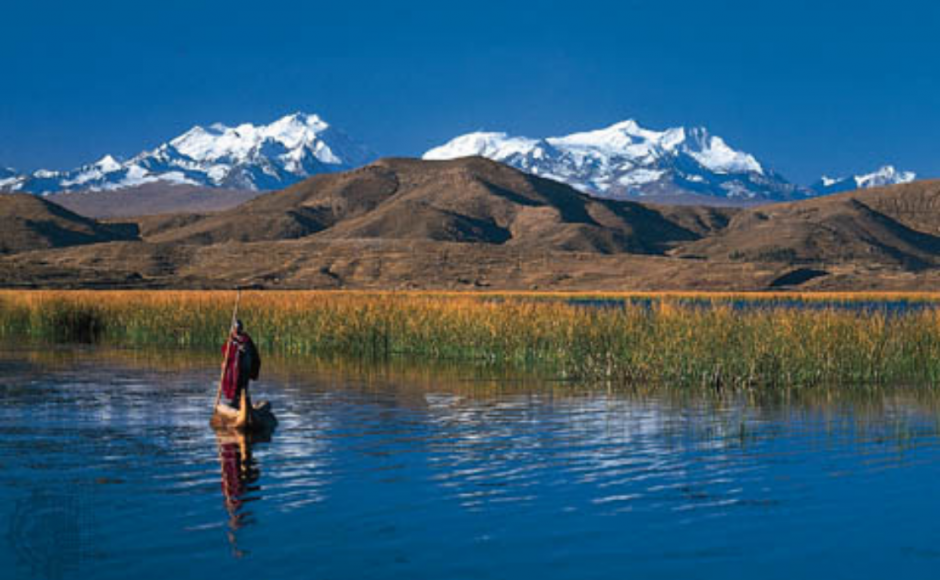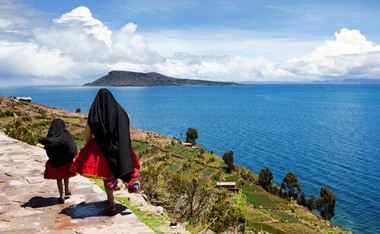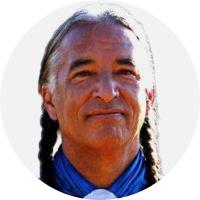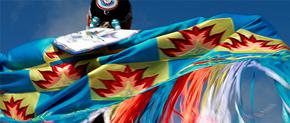The views expressed in our content reflect individual perspectives and do not represent the authoritative views of the Baha'i Faith.
Previously, in this series of essays we’ve written about and discussed the Incan prophet of God Viracocha – but he was not the only Incan Indigenous messenger.
This central teaching of the Baha’i Faith – that all of God’s messengers evince essentially one and the same spirit – applies not only to the familiar founders of Faith like Abraham, Moses, Christ, and Muhammad, but to every prophet who appeared to every people in every place. In a speech he gave in Paris, Abdu’l-Baha said as much, referring to the messengers of God as “Divine Manifestations of the Truth:”
The greatest power of the Holy Spirit exists in the Divine Manifestations of the Truth. Through the power of the Spirit the Heavenly Teaching has been brought into the World of Humanity. Through the power of the Spirit life everlasting has come to the children of men. Through the power of the Spirit the Divine Glory has shone from East to West, and through the power of the same Spirit will the divine virtues of humanity become manifest.
RELATED: The Return of Viracocha, the Prophet of the Incas

Q: Kevin, in Part 65, we cited this interesting statement from Mr. Hooper Dunbar, a highly respected former member of the Universal House of Justice – the democratically-elected global leadership body of the Baha’i Faith – that many people in South America believe that Viracocha was a “great Incan prophet” who “walked on the Lake Titicaca”:
… from a Baha’i point of view, all the teachers have been at the same college. That is, they’re inspired with the same universal knowledge. But they’re not able to deliver a message which is not relative to the time that they appear in. Christ is going to call us to a united mankind? Let the globe be one? Let the earth be one? The earth was flat when he spoke. It was still flat. Nobody knew about America except the Americans, the early Americans. They had their own messengers. But you go amongst the tribes in South America, and so on. They’ve had lesser guides and they have had greater guides. Viracocha was the great Incan prophet …. And he taught the basic virtues is what he taught. And when the Christian missionaries go and speak to them and tell them that Christ walked on the water in the Sea of Galilee, they said, ‘Oh, he may be then. He may be right, because our Viracocha walked on the Lake Titicaca. We have traditions about that!’ – Hooper Dunbar, “Introduction to the Baha’i Faith” (January 2019, Pasadena, CA), (starting at 16:33).
In “Myth of Inka Origin at Lake Titicaca,” Bernabé Cobo, a 16th century Jesuit chronicler and natural historian, observed that each of the Indigenous first nations believed that they were the original peoples of the world:
Each nation claims for itself the honor of having been the first people and says that everyone else came from them. … In fact each nation wished to place creation somewhere within its own lands. … The inhabitants of Collao are divided into two opposing views. Some hold that creation happened in Tiaguanaco; others place it on the Island of Titicaca, which is located on the great Lake Chucuito [Titicaca].
This is the very same lake that Hooper Dunbar referred to in the quote above. These perceptive statements, on the part of the erudite Jesuit padre, reflect a fairly universal phenomenon that scholars broadly refer to as “ethnocentrism.” All cultures have their specific “origin myths,” so no surprise here. Father Cobo went on to say:
The other fables that they have on this subject place the origin of man at about the time of the Flood. On the subject of the Flood these Indians had ample information. However, the only explanation that they give for the Flood is that it was caused by the will of Viracocha.
Here, there is some agreement with Mr. Dunbar’s statement. However, in the Aymara-speaking region around Lake Titicaca, the foremost god was and still is known as the Thunder-Lightning deity Tunupa (Thunupa). The Aymara, an ancient but still thriving Indigenous people, live on the altiplano (high Andean plateau) around Lake Titicaca in southern Peru.
At one point in time, Tunupa and Viracocha were two distinct deities. Tunupa, an Aymara god, predates the Inca conquest in the Kollao area of the Titicaca region. Over time, the Inca deity, Viracocha (a Quechua word) largely replaced the pre-Inca deity, Tunupa (an Aymara word), although not completely. Scholar Verónica Salles-Reese explains in her book From Viracocha to the Virgin of Copacabana: Representation of the Sacred at Lake Titicaca that this is a distinction with a real difference:
All renditions of the cosmogonic myth that I have considered indicate that Lake Titicaca is a primeval place. The variants coincide in their presentation of an extraordinary being who appears at the lake and performs an organizing or creative function and to also becomes multiple beings with similar but limited functions. This extraordinary being, who was called Viracocha in the Quechua language, seems to have been Tunupa, the god of the Aymara Indians who lived in the region hundreds of years before the arrival of the Incas.
In the ensuing mutual assimilation that shaped the evolution of a colonial Andean religion, Tunupa also came to be venerated as a Catholic saint. The Indigenous Peruvian chronicler, Santa Cruz Pachacuti Yamqui Salcamayhua, who wrote An Account of the Antiquities of Peru and lived in the area between Lake Titicaca and the Cuzco Valley during the 16th century, equated Tunupa with Saint Thomas:
I affirm that I have heard, from a child, the most ancient traditions and histories, the fables and barbarisms of the heathen times, which are as follows; according to the constant testimony of the natives touching the events of past times …
Some years after the devils called Hapi-ñuñus Achacallas had been driven out of the land, there arrived, in these kingdoms of Ttahuantin-suyu a bearded man, of middle height, with long hair, and in a rather long shirt. They say that he was somewhat past his prime, for he already had grey hairs, and he was lean. He travelled with his staff, teaching the natives with much love, and calling them all his sons and daughters. As he went through all the land, he performed many miracles. The sick were healed by his touch. He spoke all languages better than the natives. They called him Tonapa or Tarapaca (Tarapaca means an eagle) … Although he preached the people did not listen, for they thought little of him. He was called Tonapa Uiracocha nipacachan; but was he not the glorious apostle St. Thomas? …
They say that this man came to the village of a chief called Apo-tampu … very tired. It was at a time when they were celebrating a marriage feast. His doctrines were listened to by the chief with friendly feelings, but his vassals heard them unwillingly. From that day the wanderer was a guest of Apo-tampu, to whom it is said that he gave a stick from his own staff, and through this Apo-tampu, the people listened with attention to the words of the stranger, receiving the stick from his hands. Thus they received what he preached in a stick, marking and scoring on it each chapter of his precepts. The old men of the days of my father, Don Diego Felipe, used to say that Caçi-caçi were the commandments of God, and especially the seven precepts …. This worthy, named Thonapa, is said to have visited all the provinces of the Colla-suyu, preaching to the people without cessation ….
So, afterwards, Tonapa was taken prisoner and shorn, near the great lake of Carapucu. … They say that, when day broke, when Tonapa was a prisoner, a very beautiful youth came to him, and said:—“Do not fear …” So saying, he touched the cords, by which Tonapa was tied hand and foot, with his fingers. There were many guards, for Tonapa had been condemned to a cruel death. But at dawn, being five in the morning, he entered the lake with the youth, his mantle bearing him up on the water and serving in the place of a boat. … They say that Tonapa after he had been freed from the hands of those savages, remained for a long time on a rock called Titicaca … Tonapa then followed the course of the river Chacamarca until he came to the sea. This is reported by those most ancient Yncas. –
Consider this observation from Sabine MacCormack, the author of “Pachacuti: Miracles, Punishments, and Last Judgment: Visionary Past and Prophetic Future in Early Colonial Peru,” in the American Historical Review:
These Andean epochs were marked by the departure and return of founding deities; the myth of the return of the Inca thus had counterparts in the divine world. The Creator, Viracocha, had departed over the ocean but promised to return. Christian missionaries, in an endeavor to make their message more convincing, identified Tunupa from the Titicaca region, another beneficent deity whose return was expected, with the apostle Thomas, who, so it was suggested, had in former times preached in the Andes.
RELATED: Does Progressive Revelation Include Indigenous Messengers of God?
Speaking of Tunupa, Vinson Brown, in Voices of Earth and Sky, commented that:
The Spaniards thought he might have been one of the Christian saints who somehow came to America, such as Saint Thomas or Saint Bartholomew, but it could as well be assumed that the vanity of the white men did not allow them to admit that the Indians could have ever had equivalent holy beings of their own!
Kevin, from your perspective as an Indigenous person and as a Baha’i, would Baha’i recognition and respect of Tunupa be different from Catholic identification of Tunupa as a saint, or from a Mormon equivalence to Jesus Christ, or from a “New Age” religious appropriation of Indigenous spirituality? Please explain how a Baha’i-inspired, genuine recognition and respect of the Aymara sacred traditions of Tunupa would represent a distinction with a real difference.
A: The parochial perspectives above preclude the possibility of God sending messengers to this half of the planet — except, for instance, if an Indigenous messenger of God, like Tunupa, is equated with a Christian apostle, like St. Thomas. Not only was that the prevailing Christian mindset of that day and age, but such religious prejudice also persisted as a secular attitude as well. For instance, to cite a less familiar passage from a well-known document, the first page of the U.S. Declaration of Independence describes the Indigenous people as “merciless savages.”
This view sets the tone for much of the interaction between the settlers and their Indigenous hosts. From this vantage point, the original people are viewed as less than human, accursed by God, and satanic in nature.
Thankfully we live in an age awakening to the limitless bounties from on high that have been continuously revealed to humanity throughout time, no matter where they reside, through the agency of all of God’s chosen messengers. As Baha’u’llah, the prophet and founder of the Baha’i Faith wrote:
This is the Day in which God’s most excellent favors have been poured out upon men, the Day in which His most mighty grace hath been infused into all created things. It is incumbent upon all the peoples of the world to reconcile their differences, and, with perfect unity and peace, abide beneath the shadow of the Tree of His care and loving-kindness.
It is a blessing and an enlightenment to learn more of Tunupa and the sacredness of his teachings.

















Comments
Sign in or create an account
Continue with Googleor